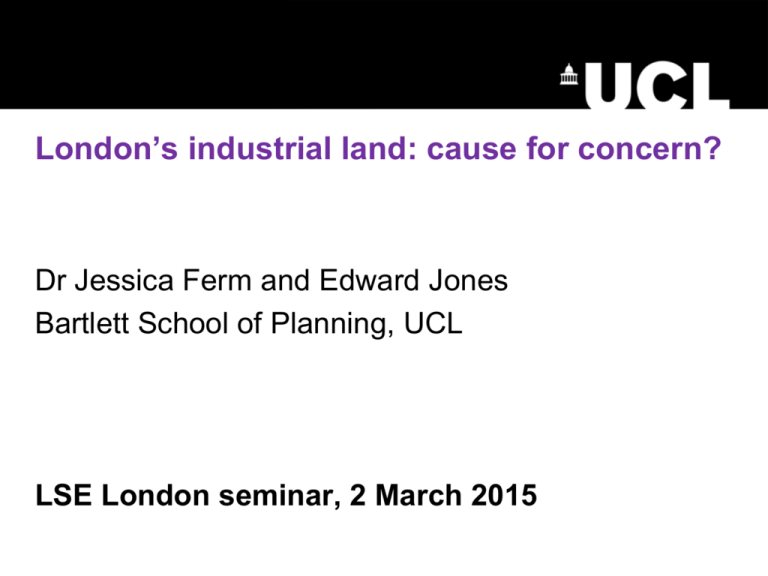here.
advertisement

London’s industrial land: cause for concern? Dr Jessica Ferm and Edward Jones Bartlett School of Planning, UCL LSE London seminar, 2 March 2015 “Industrial areas in London are not well-understood. Most people have no idea what is made and assembled in their borough, because industrial areas are unwelcoming and do not have a public face” (Gort Scott, 2013) Abbey Industrial Estate, Wembley (© Jessica Ferm) THE CHALLENGE FOR LONDON CENTRAL PROJECTION: 3.5m (37%) growth (2011-2050) Source: GLA Intelligence (2013) Population and employment projections to support the London Infrastructure Plan 2050. http://data.london.gov.uk/dataset/gla-employment-projections (adapted by Jenny Jones, Feb 2015) Challenge for the Mayor Accommodate “growth within the capital’s boundaries and without intruding strategically on its protected green and open spaces” (Draft Further Alterations to the London Plan, Jan 2014) ‘Managed release’ of industrial land (London Plan, 2011) Classifications of industrial land • Strategic Industrial Locations – loss only permitted if part of a coordinated process of consolidation e.g. Opportunity areas • Locally Significant Industrial Sites – regular reviews of supply and demand to justify continued protection • Other Industrial Sites – not protected, to be carefully managed by boroughs, together with LSIS make up 50% London’s industrial capacity Loss of industrial land since 2001 APPROX TWICE GLA benchmark for ‘managed release’ Research questions • Is deindustrialisation driving the loss of industrial land? • Who occupies space on London’s industrial land? • How important are these businesses for London? • Can we protect these businesses AND promote mixed use redevelopment on our industrial land? The study: Pulls together and reframes existing research and information INDUSTRY IN LONDON AND THE ROLE OF PLANNING Industry in London – historical context “the capital was clearly the most important single seat of manufacturing industry in the country, accounting for between one and six and one in seven of all manufacturing workers in 1861, over one in six in 1921, and over one in five in 1951. Manufacturing occupied nearly one in three of all workers in London in 1861 and one in three in 1951” (The Industries of London, Peter Hall, 1961: 23) • London’s industry – diverse not specialist • End of the production chain • Proximity to large and wealthy market – access to national and international • Both specialist and cheap labour • Diversification and expansion beyond inner belt • • • • Decentralisation Protect and invest (1940s – 1970s) (1970s – 1980s) Barlow Commission (1940) Greater London Plan (1944) Distribution of Industry Act (1945) Industrial Development Certificates (IDCs) • • • • Policy for the Inner Cities Inner Urban Areas Act (1978) Industrial Improvement Areas GLC: London Industrial Strategy (1984) Urban renaissance and mixed use (1990s+) • • • Richard Rogers “Cities for a Small Planet” (1997) Urban Task Force “Towards an Urban Renaissance” (1999) Compact City philosophy ‘Market realism’ (2000s+) • • • ‘Employment land reviews guidance note’ (ODPM, 2004) PPS4 ‘Planning for Sustainable Growth’ (2008) National Planning Policy Framework (2012) Urban renaissance Housing is one of the keys to consolidating the neighbourhoods of our city. The way to meet the huge demand and to strengthen our existing communities is to redevelop derelict and brown land to produce dense, compact and mixed developments. (Rogers and Gumuchdjian, 1997: 118) For and against industrial ‘zoning’ AGAINST • Market allocates scarce resources most efficiently • Zoning is outdated, does not support compact, mixed-use cities, is unsustainable FOR • Planning can correct market failures • Prevents land value inflation, supports agglomeration of lowvalue small firms • More efficient, less costly allocation of infrastructure • Provides flexibility • Promotes social equity REAL ESTATE SPECULATION NOT DEINDUSTRIALISATION What might be driving the loss? • Loss of industrial land above GLA benchmarks suggests something else is going on over and above deindustrialisation • Impact of real estate speculation and planning policy NOT taken into account • Evidence from Brooklyn, NY of displacement of industry due to real estate speculation for loft conversions reinforced by city planners (Curran 2004, 2007) Evidence from London • Speculative office development in 1980s commercial boom displaced small manufacturers in Shoreditch, facilitated by changes to Use Classes Order 1987 • Camden and Islington employment land reviews (2008, 2011) – planned reductions in supply and predictions of continuing loss despite high demand and low vacancy rates There has been pressure to redevelop the borough’s stock of land used for employment purposes, particularly manufacturing and industry, for higher value uses, principally housing. Once employment land in the borough has been developed for an alternative use it is very unlikely it will ever be returned to industrial use. There has been virtually no new provision of such premises in the borough for many years Camden Core Strategy (2010) Evidence from London’s industrial estates • Rumours and speculation of threat create uncertainty, unwillingness to invest and commit • In anticipation of redevelopment, landlords are offering increasingly short and insecure leases • Leads to vacancies, high turnover, strengthening the case for redevelopment MANUFACTURING IS CHANGING BUT IT’S NOT DEAD • Larger companies are being replaced by smaller firms • Diversity and complexity Images from Gort Scott (2013) • Growth of niches such as artisanal manufacturing, production of luxury goods, smaller food and drink manufacturers • In London, productivity is strong, high GVA INDUSTRIAL LAND ACCOMMODATES A RANGE OF DIVERSE BUSINESSES AND ACTIVITIES, VITAL TO LONDON • Manufacturing is changing • But manufacturing is not the dominant activity Image from Ramidus (2013) Image from GLA (2014) Servicing the city London’s Strategic Infrastructure Image from Closed Loop Image from GLA Image from Hugo Glendinning • Cultural and creative industries • Other diverse, small occupiers BUSINESSES ON INDUSTRIAL LAND ARE PART OF A DELICATE LOCAL ECOLOGY Interdependencies in London’s economy • Can firms simply move ‘elsewhere’? • Place-specific supporting infrastructure “If you look at our employees where they live, it’s like a circle around this place. So to move out from the middle of the circle, we’d cause problems for ourselves. It’s like a craftsmanship job that we do here, and it’s good to have those skilled people to do it. It’s not so easy. Certain types of industry, you get rid of these people, and you get other people. And you start someplace else. It’s like nothing. Our business is different than that.” Clothing manufacturer in Williamsburg, from Curran (2010) Image from ninebelow via flickr “As businesses started to move, I started to lose customers because all of the businesses round here are linked.” From Raco and Tunney (2010) “At the moment, 80 per cent of our business customers are within a 2mile radius. A lot are moving or have already moved. Two of our main customers used to live next door— now we’ve lost them.” “Premises suitable for industrial, manufacturing and warehousing businesses provide jobs for people who would otherwise be at high risk of being unemployed or workless. The Camden employment land review 2008, using data from the National Employer Survey 2003 and the Annual Business Inquiry 2006, found that the skills required for these sectors are fundamentally different from other sectors with similar qualification level requirements, such as retail, leisure and hospitality. Therefore, it is unlikely that the retail or hospitality sectors will provide straightforward alternative job opportunities for people losing industrial/warehousing jobs in the borough.” LB Camden Core Strategy, 8.12 Images from LSE Cities and Hall (2013) Images from Gort Scott A RETURN TO THE 19TH CENTURY INDUSTRIOUS CITY? Celebrating manufacturing “There is an opportunity to move away from the rooted practice to design these sectors out of our towns and cities. Let’s make them visible again and stop housing them in anonymous sheds. Let’s re-appropriate industrial estates and districts through raising the quality of their design and maintenance. As a result, local communities could have a better understanding of how their local economy is formed and develop a sense of ownership. Let’s celebrate manufacturing industry again.” Urban Design Group, 2014: 2 Category 1 sites Category 2 sites Category 3 sites • • • Articulated HGV access 24 hour operation Single storey premises, 5-6m min floor to ceiling heights • Access for large commercial vehicles 24 hour operation Multi storey premises with goods lift • • • • • Poor access Incompatible neighbouring residential uses Restricted operational hours Typology from Roger Tym and Partners (2011) ‘Business premises study’ A cautious approach to mixed use • In London, strength of the residential property market and the imbalance of land values • New housing in industrial areas undermines the important function of industrial land being to protect lower-value commercial uses from competition from higher land values, • Raises expectations that further redevelopment can take place – ‘hope values’. Conclusions: drivers of loss • Loss of industrial land due to real estate speculation, fuelled by planning policy • Predictions of future employment in manufacturing and industry do not take into account the role that development pressure and planning policy have played in past loss Conclusions: nature and importance of industrial land • London’s industrial areas are vibrant and diverse • Manufacturing is not dead • Flexibility and affordability of premises attracts a range of other activities • Delicate ecology, much is hidden • Relocation is difficult • Vital for London and Londoners Conclusions: Implications for policy • No effective mechanisms within the UK legislative and planning system to manipulate land values within mixed-use context. • Extension of permitted development rights – imminent threat • A positive approach is required, acknowledging importance of industrial land as a vital component of a compact, smart city, not a barrier. Further reading: • Ferm, J. and Jones, E. (2015) London's Industrial Land: Cause for Concern? UCL (University College London): London, UK. Available at: https://justspacelondon.files.wordpress.com/2015/02/ferm-joneslondons-industrial-land-working-paper-final1.pdf • Just space Economy and Planning response to consultation on the Further Alterations to the London Plan: https://justspacelondon.files.wordpress.com/2014/04/falp-jsepresponse.pdf Jenny Jones’ (Green Party London Assembly member) campaign: • “The End of Industry in London?” report (Feb 2015): https://www.london.gov.uk/media/assembly-member-pressreleases/green-party/2015/02/mayor-plans-for-london-manufacturingto-disappear-within-fifty • Blog: http://www.citymetric.com/business/london-doesnt-only-needhouses-we-should-protect-its-industrial-land-too-783 • Article: http://leftfootforward.org/2015/02/londons-industry-is-beingcleared-for-a-luxury-flat-monoculture/ • BBC London coverage: https://www.youtube.com/watch?v=UaMYGZXojdY • Jenny Jones questions Deputy Mayor for Planning, Sir Edward Lister: https://www.youtube.com/watch?v=o10bOvYBkcM








